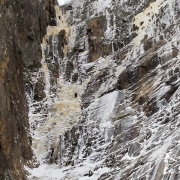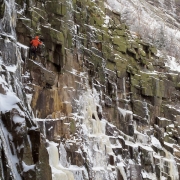
December 23, 2012
Sunday I was able to get out with Boris for some climbing. The original plan was to head to the Black Dike on Cannon Mtn, but since Boris hasn’t gotten any pitches of ice in under his belt we decided perhaps doing something on Mt. Washington would be better. That was until the Observatory predicted low single digit temps and 85-105 mph winds for the summit. We decided that those conditions also weren’t favorable for a first trip out for Boris–I had already gotten four days of climbing in Bozeman–so we settled on going back to the original plan on Cannon.
Our start from D’Acres in Dorchester was a little later than we’d expected, leaving there at 9:30am. The drive to Cannon isn’t far, a little less than an hour. As we suited up the view from the parking lot on the Black Dike was good–much better than last time I was here. Some wispy clouds billowed over the summit but for the most part the skies were clear and the temps in the low 20’s. While our plan was to climb the Dike the breakdown of the pitches was undetermined.
The approach up was less than stellar. The rain from two days prior had frozen in many places and was covered with an inch of light snow, making for slippery conditions even in the woods. Once getting out of the woods we slipped and slid our way up the boulder field below the massive face of Cannon Mtn’s east side. The snow was not sufficient to cover the holes in the boulders nor was it enough to freeze them in place. Every step was a cautious balancing act in mountaineering boots and dorm fridge sized boulders shifted and slid as we walked across them. During the approach we could see two teams on the Dike, one just getting to the end of the first pitch and another part just in front of them.
Boris claimed the first pitch since it would be his warm up to ice for the season. The long first pitch is a bunch of steps and isn’t harder than WI3, but still had a few interesting bulges to surmount before getting to the ice screw belay “ledge”. As we put on our harnesses another party, Adam and Caroline, came up and we chatted for a bit. They are guides and split their time between Chamonix, Salt Lake, and New Hampshire. Their plan was to follow another party up Fafnir (WI5+) to the right of the Black Dike.

Boris headed up the first pitch and for not swinging the tools at all this season looked pretty good and didn’t have much trouble. I headed up after the belay was on. The stained yellow ice looked a bit like frozen iced tea. The rain a couple of days before and the moderate temperatures made for some good sticky ice for the most part, though a few chunks came sailing down from some of the other parties above. After reaching the belay it was decision time.
Normally the etiquette of climbing is that you “swing” leads. This means swapping which climber heads up the next pitch. There’s a few reasons for this but biggest are to keep rope management easier and to give both climbers the chance to have the excitement of leading. However, Boris is a stronger climber than I am and the Black Dike has been called by the father of modern ice climbing, Yvon Chouinard, a “black, filthy, horrendous icicle.” Even he didn’t get the first ascent. It was time for me to lead and decide if I was up to leading the crux pitch. And did I mention that I hadn’t lead any ice in Bozeman?
On the second pitch the ice begins to thin out and there is a traverse left across rock to gain a long ice runnel on the left side of the cleft. The rock section on this day only happened to be about eight feet wide, just a few moves. Looking at it for a while I decided the feet were good and there was some pro because of a rappel anchor. The anchor would be at my feet for the traverse but it still was there–not that falling with sharp things at my hands and feet is what I wanted to do though.
I decided to go all in and do it. Heading up I placed a 19cm screw in the last place I could before heading into the traverse. Getting to the rappel anchors it was obvious that the other parties we’d seen ahead of us hadn’t gone this way. The dusting of snow overnight was still settled on the footholds I was looking to use. The other parties had used a higher traverse, which had more rock, less positive feet but an easier transition into the ice.

Inspecting and clipping into the rappel anchors I stepped up to the ledges. The feet were good enough to place a whole crampon on, but the placements for the tools was poor. Everything was slopey or not quite positive enough for my tastes. No cracks to slot tools into either. After a couple of minutes of cleaning off the snow I was able to find a reasonably good right placement on which I could shift my feet. This got my left tool within striking distance of the steep runnel. Delicately looking for just the right spot for my tool I was able to stick it in some solid tea colored ice. With a solid left placement I looked for another right placement so that I could stick my left crampon into the ice. Eventually I found something that worked well enough and got my left side established into the ice. Inching over I was able to swing the right tool in and headed up a few feet to a good rest. Unfortunately the ice wasn’t really all that deep and so I kept moving up for my first piece of pro after the traverse. I can’t remember if I placed a 13cm screw or if I placed the brown tricam next, but either way it was a relief to have some good protection after the dicey traverse.
Moving farther up the runnel it was all similar climbing to what I’d done in Bozeman a few weeks prior. Narrow spaces with plenty of opportunities to stem, chimney, and counterbalance off of rock or ice on either side. Placing a couple more screws and clipping some buried pink tricams I wondered where the anchors were. The climbing was fun but I was very glad to pull up the last bulge and see the fixed gear on the left side of the runnel.
Boris made a little quicker work of the pitch than I did, understandably. While I was at the belay I was able to get a good view of the two parties next to us on Fafnir. They’d gotten to the third pitch and run out of ice. Adam and Caroline decided to head a bit left and had about 50 feet of dry tooling to content with. Adam made a bunch of rock moves in gloves and from a precarious looking stance pounded in a piton. I’ve not driven in any iron before but the progressively higher pitched ring of a good piton going in is a reassuring sound–even when I’m just watching. The other party, Majka Burhardt and Peter Doucette, went farther right and had a similar adventure, though there was a bit more ice for them.

We looked at the time, 2:45pm. Our late start and the difficulty of the route had caught up with us. Sunset at 4:15pm was coming and though the third pitch looked inviting we decided to rappel so we could hike out in daylight. This turned out to be a good decision since there were many slips on the way through the boulder field and even in the woods below them. Once at the car we celebrated with a shot of 12 y.o. Scotch. Boris’ first ice of the season went well and my successful lead of the crux pitch of perhaps the most notable ice climb in the Northeast also went off without a hitch.








